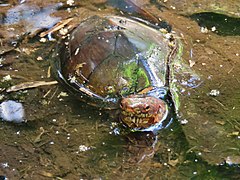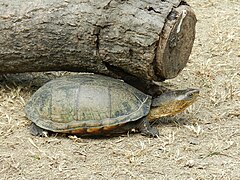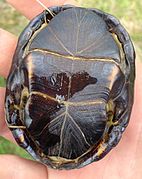Kinosternon
| Kinosternon | |
|---|---|

| |
| Mississippi mud turtle Kinosternon subrubrum hippocrepis | |
| Scientific classification | |
| Domain: | Eukaryota |
| Kingdom: | Animalia |
| Phylum: | Chordata |
| Class: | Reptilia |
| Order: | Testudines |
| Suborder: | Cryptodira |
| Superfamily: | Kinosternoidea |
| Family: | Kinosternidae |
| Subfamily: | Kinosterninae |
| Genus: | Kinosternon Spix,1824[1] |
Kinosternonis agenusof small aquaticturtlesfrom theAmericasknown commonly asmud turtles.
Geographic range
[edit]They are found in the United States,Mexico,Central America,and South America. The greatestspecies richnessis in Mexico, and only three species (K. dunni,K. leucostomum,andK. scorpioides) are found in South America.
Description
[edit]They are very similar to themusk turtles,but generally smaller in size, and theircarapacesare not as highlydomed.
Diet
[edit]All mud turtles arecarnivorous,consuming various aquaticinvertebrates(especiallymolluscsandworms[2]),fish,and evencarrion.
Behavior
[edit]Mud turtles live in the ground layer on the bed of bodies of slowly-flowing or still water. By burrowing deeply into mud, mud turtles are protected from danger. They occasionally like to bask in the sun.[2]
Species
[edit]Extant
[edit]- Central Chiapas mud turtle-K. abaxillare(Baur, 1925)
- Tabasco mud turtle-K. acutumGray,1831[1]
- Alamos mud turtle-K. alamosaeBerry& Legler, 1980[1]
- Central American mud turtle-K. angustiponsLegler, 1965[1]
- Striped mud turtle-K. baurii(Garman,1891)[1]
- Jalisco mud turtle-K. chimalhuacaBerry,Seidel,&Iverson,1996[1]
- Cora mud turtle-K. coraLoc-Barragánet al., 2020[3]
- Creaser's mud turtle-K. creaseriHartweg, 1934[1]
- Dunn's mud turtle-K. dunniSchmidt,1947[1]
- Durango mud turtle-K. durangoenseIverson, 1979[1]
- Yellow mud turtle-K. flavescens(Agassiz,1857)[1]
- Herrera's mud turtle-K. herreraiStejneger,1925[1]
- Rough-footed mud turtle-K. hirtipes(Wagler,1830)[1]
- Valley of Mexico mud turtle -K. h. hirtipes(Wagler, 1830)[1]
- Lake Chapala mud turtle -K. h. chapalaenseIverson, 1981[1]
- San Juanico mud turtle -K. h. magdalenseIverson, 1981[1]
- Viesca mud turtle -K. h. megacephalumIverson, 1981 (extinct)[1]
- Mexican plateau mud turtle -K. h. murrayiGlass and Hartweg, 1951[1]
- Patzcuarco mud turtle -K. h. tarascenseIverson, 1981[1]
- Mexican mud turtle-K. integrum(LeConte, 1954)[1]
- White-lipped mud turtle-K. leucostomumA.M.C. Duméril,Bibron&A.H.A. Duméril,1851[1]
- Oaxaca mud turtle-K. oaxacaeBerry & Iverson, 1980[1]
- Scorpion mud turtle-K. scorpioides(Linnaeus,1766)[1]
- Sonora mud turtle-K. sonoriense(Le Conte,1854)[1]
- Florida mud turtle-K. steindachneri(Siebenrock,1906)[4]
- Arizona mud turtle-K.stejnegeriGilmore, 1923[1][5]
- Eastern mud turtle-K. subrubrum(Bonnaterre,1789)[1]
- Vallarta mud turtle-K. vogtiLópez-Lunaet al., 2018[6]
Extinct
[edit]†Kinosternon arizonenseGilmore, 1923(known fromPlio-Pleistocenefossilremains, formerly consideredconspecificwithK. stejnegeri)[1][5]
-
Tabasco mud turtle (Kinosternon acutum) 6 March 2018.
-
Arizona mud turtle (Kinosternon arizonense), 25 October 2018.
-
Creaser's mud turtle (Kinosternon creaseri), juvenile from Yucatán, México.
-
Mexican mud turtle (Kinosternon integrum), a sub-adult from the Municipality of Tula, Tamaulipas, Mexico (20 September 2003).
-
Oaxaca mud turtle (Kinosternon oaxacae) La Soledad, Oaxaca, Mexico.
-
Scorpion mud turtle (Kinosternon scorpioides), southern Tamaulipas, Mexico (23 September 2004).
-
Sonoran mud turtle (Kinosternon sonoriense), male.
-
Eastern mud turtle (Kinosternon subrubrum) plastron.
References
[edit]- ^abcdefghijklmnopqrstuvwxyzaaabacadaeafagahaiRhodin 2010,p. 000.95-000.98
- ^abObst, Fritz Jürgen (1986).Turtles, Tortoises, and Terrapins(1 ed.). New York: St. Martin's Press. p. 112.ISBN0-312-82362-2.
- ^Loc-Barragán, Jesús A.; Reyes-Velasco, Jacobo; Woolrich-Piña, Guillermo A.; Grünwald, Christoph I.; Anaya, Myriam Venegas De; Rangel-Mendoza, Judith A.; López-Luna, Marco A. (27 November 2020)."A New Species of Mud Turtle of Genus Kinosternon (Testudines: Kinosternidae) from the Pacific Coastal Plain of Northwestern Mexico".Zootaxa.4885(4): 509–529.doi:10.11646/zootaxa.4885.4.3.PMID33311258.
- ^Rhodin, Anders G.J.; Inverson, John B.; Roger, Bour; Fritz, Uwe; Georges, Arthur; Shaffer, H. Bradley; van Dijk, Peter Paul (August 3, 2017)."Turtles of the world, 2017 update: Annotated checklist and atlas of taxonomy, synonymy, distribution, and conservation status(8th Ed.)"(PDF).Chelonian Research Monographs.7.ISBN978-1-5323-5026-9.RetrievedOctober 4,2019.
- ^abMcCord, Robert D. (2016-02-17). "What is Kinosternon arizonense?".Historical Biology.28(1–2): 310–315.Bibcode:2016HBio...28..310M.doi:10.1080/08912963.2015.1053879.ISSN0891-2963.S2CID85572922.
- ^López-Luna, Marco A.; Cupul-Magaña, Fabio G.; Escobedo-Galván, Armando H.; González-Hernández, Adriana J.; Centenero-Alcalá, Eric; Rangel-Mendoza, Judith A.; Ramírez-Ramírez, Mariana M.; Cazares-Hernández, and Erasmo. "A Distinctive New Species of Mud Turtle from Western México".Chelonian Conservation and Biology.2018.
- Bibliography
- Rhodin, Anders G.J.; van Dijk, Peter Paul; Iverson, John B.; Shaffer, H. Bradley (2010-12-14)."Turtles of the world, 2010 update: Annotated checklist of taxonomy, synonymy, distribution and conservation status"(PDF).Chelonian Research Monographs.5.Archived fromthe original(PDF)on 2011-07-17.








